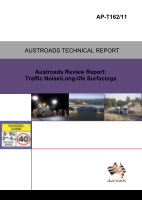Pavement

- Publication no: AP-T162-11
- ISBN: 978-1-921709-57-9
- Published: 1 February 2011
- PDF (free) Download
This report provides a review on surface characteristics in relation to traffic noise and long-life surfacings. For the conventional asphalt surfacings in general road construction practice, the selection of mix type and size would define two most important parameters (i.e. texture spectrum and air voids) affecting the noise contribution of the surfacing. Once a mix was selected, further noise reduction could be trialled by controlling the aggregate grading and binder content (two of the key factors in mix design) within the specification limits. Using aggregates from a different source could also be considered, since inherent aggregate characteristics (e.g. shape, microtexture) would also influence the noise contribution of the surfacing to a certain degree. Where an extremely low noise surfacing is required, special ‘low noise surfacing products’ can be considered. However, these products are not conventional and need to be examined and their performance validated as satisfactory in other more important aspects (e.g. resistance to traffic load, skid resistance, cost etc.).
- 1. INTRODUCTION
- 2. ROAD SURFACE CHARACTERISTICS AND TRAFFIC NOISE
- 2.1. Introduction to Sound and Noise
- 2.2. Traffic Noise
- 2.3. Noise from Tyre/Road Interaction
- 2.3.1. Tyre/Road Noise Generation Mechanism
- 2.3.2. Tyre/Road Noise Measurement Methods
- 2.4. Road Surface Characteristics and Noise
- 2.4.1. Texture
- 2.4.2. Air Voids (Permeability) and Layer Thickness
- 2.4.3. Other Factors
- 2.5. Texture Properties to Provide Low Noise Surfacing
- 2.5.1. Open Grade (OG) Asphalt Surfacings
- 2.5.2. Dense Grade and SMA Surfacings
- 2.5.3. Sprayed Seal Surfacings
- 2.5.4. Concrete Surfacings
- 2.6. Low Noise Surfacings
- 2.6.1. Surface Treatments
- 2.6.2. Thin Surfacings
- 2.6.3. Double Layer Open Grade Surfacings
- 2.6.4. Porous Cement Concrete
- 2.6.5. Exposed Aggregate Cement Concrete (EACC)
- 2.6.6. Crumb Rubber Mix
- 2.6.7. Special Surfacings
- 2.7. Discussion on Traffic Noise
- 3. REVIEW OF LONG-LIFE SURFACINGS
- 3.1. Definition of Long-life Surfacing
- 3.2. OECD Study on Long-life Surfacings (Phase I)
- 3.2.1. Polymer Modified Binders (PMBs)
- 3.2.2. Epoxy Asphalt
- 3.2.3. Portland Cement Concrete (PCC)
- 3.2.4. High-performance Cementitious Materials (HPCM)
- 3.2.5. Composite Pavement
- 3.2.6. Seals with Synthetic Binders
- 3.2.7. Recommendation
- 3.3. OECD Study on Long-life Surfacings (Phase II)
- 3.3.1. Epoxy Asphalt
- 3.3.2. HPCM
- 3.4. Discussion on Long-life Surfacings
- REFERENCES
